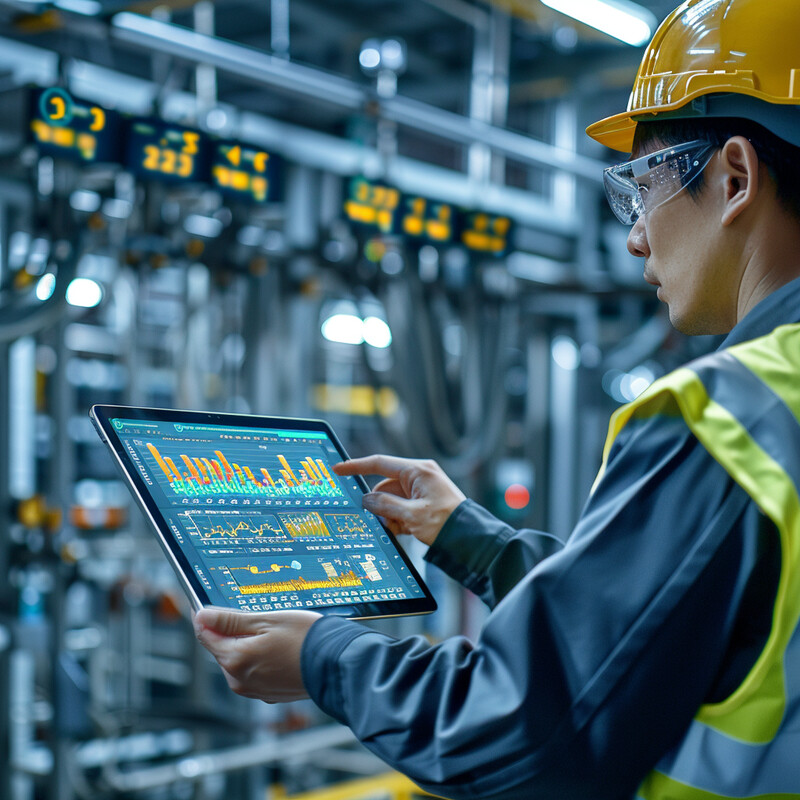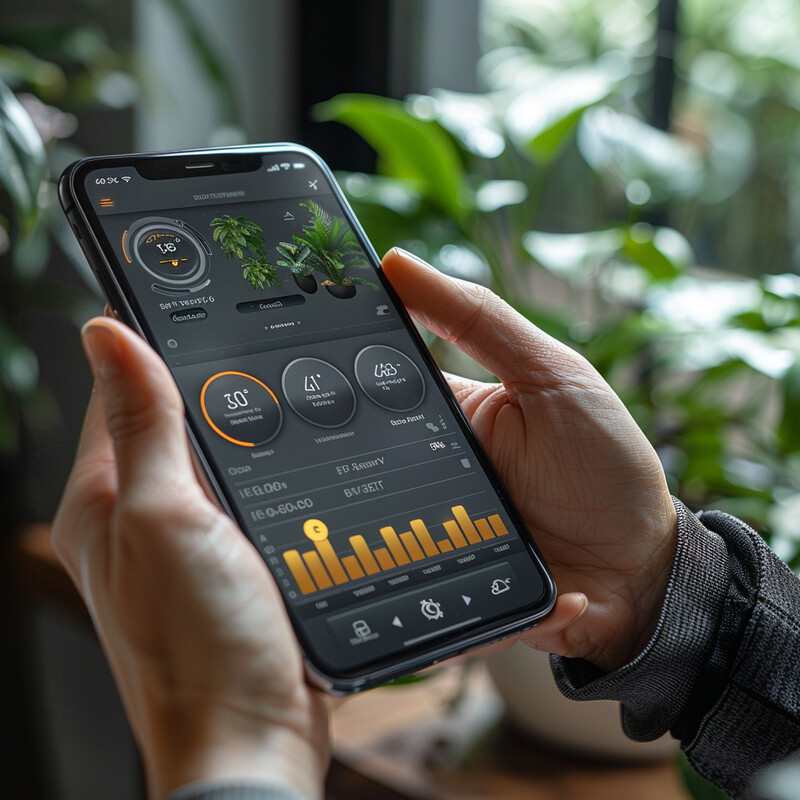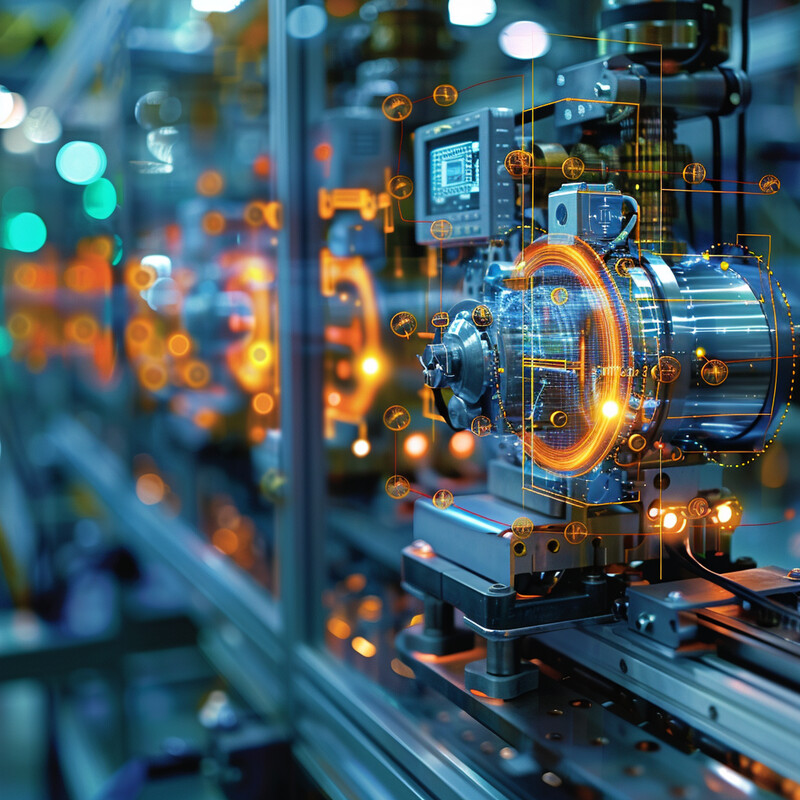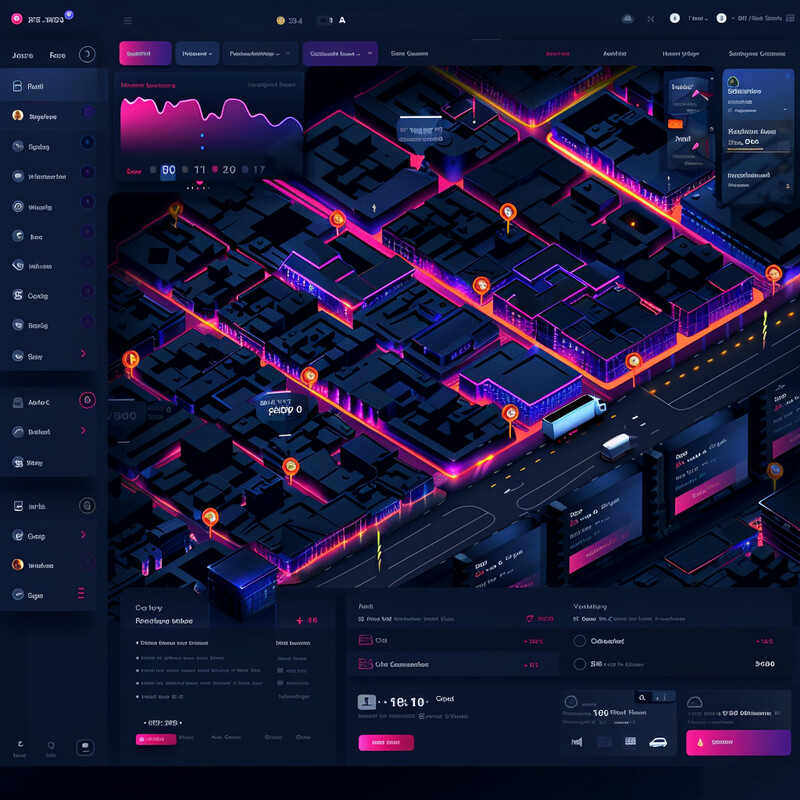1. Smart Grid Management
AI plays a pivotal role in modern smart grid management by balancing electricity supply and demand in real time. It analyzes vast streams of grid data (from smart meters, sensors, etc.) to predict peak usage and adjust power flows dynamically. This ensures efficient distribution of electricity, reduces overloads, and helps prevent outages by responding faster than human operators. AI also facilitates the integration of renewable energy into the grid by anticipating variability and smoothing out fluctuations. Overall, AI-driven control makes the grid more resilient and efficient, minimizing energy waste and operational costs while maintaining stability.

AI-driven smart grid initiatives have already shown measurable improvements. For example, Singapore’s national grid has implemented AI-based management systems that reduced energy waste by roughly 8% and improved overall grid reliability through better load balancing. By continuously analyzing consumption patterns and grid conditions, the AI system optimizes energy routing and curtails excess generation, directly translating into lower losses and fewer outages. Such outcomes demonstrate how AI can make power delivery more efficient and dependable even in complex urban grids.
2. Predictive Maintenance
In energy infrastructure and industrial settings, AI-based predictive maintenance is transforming how equipment upkeep is handled. Machine learning models ingest sensor data from turbines, transformers, and other machinery to detect subtle signs of wear or anomalies. By predicting failures before they happen, AI allows maintenance to be scheduled proactively rather than reactively. This minimizes unexpected downtime of power plants or grid components and keeps systems running at optimal efficiency. In addition to preventing costly outages, this approach extends the lifespan of equipment and improves safety, since potential issues are addressed under controlled conditions instead of during emergencies.

Studies indicate that AI-driven predictive maintenance can dramatically reduce unplanned downtime and maintenance costs. According to a McKinsey analysis, implementing AI predictive maintenance in industrial operations can cut unplanned equipment downtime by up to 50%, while reducing maintenance expenses by 10–40%. In practice, utilities that have adopted such AI systems report far fewer sudden equipment failures. For example, early detection of transformer overheating or generator vibration anomalies means repairs can occur during scheduled maintenance windows, avoiding energy supply interruptions and saving millions of dollars in emergency fixes and lost production.
3. HVAC Optimization
AI greatly enhances the efficiency of heating, ventilation, and air conditioning (HVAC) systems in buildings. Traditional HVAC controls often follow fixed schedules or simple thermostatic responses, but AI controllers can learn and predict the thermal needs of a building. By taking into account occupancy patterns, weather forecasts, time of day, and even room-by-room usage, AI algorithms adjust temperatures and airflow more intelligently. This means cooling or heating is delivered precisely when and where needed – for instance, pre-cooling a room before a meeting starts or dialing back HVAC in unoccupied areas. Such fine-tuned control maintains comfort for occupants while avoiding excess energy consumption, making climate control much more energy-efficient.

Recent research underscores the significant savings AI can achieve in HVAC systems. A 2024 study by Lawrence Berkeley National Lab found that applying AI to HVAC controls in commercial office buildings could reduce energy consumption by about 8–19% compared to business-as-usual scenarios. In one real-world example, an AI-driven HVAC management system installed at a large Manhattan office building cut HVAC energy use by 15.8% over 11 months, saving over $42,000 in electricity costs and 37 metric tons of CO2 emissions. These results show that AI optimization not only trims energy waste substantially but also lowers operating costs and carbon footprints for building owners.
4. Energy Demand Forecasting
AI improves the accuracy of energy demand forecasting for utilities and grid operators. By analyzing historical consumption data, weather forecasts, economic indicators, and even social patterns, machine learning models can predict future electricity demand more precisely than traditional methods. These AI forecasts help grid managers plan generation and purchasing schedules to meet demand without over-producing (which wastes energy) or under-producing (which risks blackouts). Improved demand forecasting also informs demand response programs, where consumers are encouraged to shift or reduce usage during predicted peak times. In sum, AI-based forecasting creates a smarter balance between supply and demand, enabling more efficient dispatch of power plants and smoother integration of renewables that have variable output.

AI’s advanced pattern recognition has led to exceptionally high forecasting accuracy in practice. In Japan, for instance, utility operators introduced AI models to project electricity demand and reported that these systems achieved over 90% prediction accuracy, which helped cut grid instability during peak periods by around 15%. Such high precision means utilities can trust the forecasts to allocate resources optimally – turning on just enough generators or battery storage ahead of a hot summer evening, for example. The result is a reduction in costly reserve margins and emergency measures. Similarly, several U.S. utilities using AI-driven demand forecasting have seen improved reliability and lower operating costs, as they avoid oversupplying energy and can better prevent stress on the grid when demand spikes.
5. Renewable Energy Integration
AI is crucial for integrating renewable energy sources like solar and wind into the power grid more effectively. Renewable output is intermittent – solar panels only generate during sunny periods and wind turbines when the wind blows – which can cause supply swings. AI helps manage this variability by forecasting renewable generation, controlling energy storage, and adjusting traditional generators in real time. For example, AI can predict a drop in solar output due to an approaching cloud cover and preemptively increase output from other sources or draw from batteries. It can also decide the optimal times to charge batteries with excess solar power and discharge them when needed. These intelligent decisions ensure that as much renewable energy as possible is utilized (instead of being wasted or “curtailed”) and that the grid remains stable even with a high share of green energy.

The impact of AI on renewable integration is evident in operational improvements. Google’s DeepMind team applied AI to wind farm management in the United States and succeeded in increasing the economic value of wind energy by about 20%. The AI system uses machine learning to forecast wind power output 36 hours ahead and schedules energy deliveries more profitably, effectively mitigating the unpredictability of wind. In Denmark, on a national scale, AI-driven wind forecasting improved accuracy sufficiently to reduce excess wind energy wastage by 5–7%, meaning more renewable electricity is actually used instead of being curtailed. These examples show how AI not only smooths out the variability of renewables but also boosts their contribution to the energy mix by reducing periods of oversupply or shortfall.
6. Building Energy Management
AI enhances building energy management by optimizing the operation of lighting, climate control, and other systems in a coordinated way. In smart buildings, AI platforms process data from occupancy sensors, thermostats, lighting systems, and equipment to learn how energy is used throughout the day. The AI can then make real-time decisions: for instance, dimming or turning off lights in empty rooms, adjusting HVAC settings when people leave an area, or powering down idle elevators and electronics. It can also anticipate changes, like cooling a building overnight more cheaply and then reducing HVAC load during expensive peak hours. By continuously learning and refining its control strategies, AI ensures that buildings use only the energy they need to maintain comfort and functionality. This reduces wasteful consumption in commercial offices, campuses, and even homes without requiring constant human oversight.

The efficiency gains from AI-driven building management are significant. Field studies and implementations have found that AI-based systems can trim energy usage in commercial buildings by 8–12% on average through intelligent control of lighting and HVAC systems. For example, a smart building program in Singapore employed AI to integrate HVAC and lighting controls based on real-time occupancy data and achieved about 10% reduction in energy consumption. Similarly, many U.S. building operators using AI energy management dashboards report immediate savings in the 5–15% range just from automated adjustments and identifying inefficiencies. These savings not only lower utility bills but also contribute to lower peak demand on the grid, especially when multiplied across large building portfolios.
7. Industrial Automation
In the industrial sector, AI is optimizing manufacturing and industrial processes to reduce energy consumption. Factories consist of numerous machines and process steps – AI algorithms can analyze production data to find ways to run these processes more efficiently. For instance, AI can schedule heavy energy-using tasks (like running an industrial furnace or compressor) during times of lower overall demand or when renewable power is plentiful. It can also fine-tune control settings on equipment for maximum energy efficiency (such as optimizing motor speeds, temperatures, or pressures) without compromising output quality. Robotics and assembly lines guided by AI vision systems can minimize idle time and material waste, indirectly saving energy as well. By orchestrating the entire production line in an optimal manner, AI reduces the energy per unit of product made, which improves both the company’s bottom line and its environmental footprint.

Industrial firms adopting AI-driven energy management have reported clear improvements in energy efficiency. One analysis of AI applications in Italy’s manufacturing sector showed that advanced AI process controls led to roughly a 10% increase in energy efficiency on production lines. Concretely, this means processes that previously might consume 100 kWh now only use about 90 kWh for the same output, after AI optimization. These savings come from many small optimizations – for example, an AI system might discover it can turn off certain machines a few minutes earlier or lower peak power draw without affecting production volume. At a larger scale, companies like Siemens and General Motors have integrated AI in their factories and observed energy reductions on the order of 5–15%, alongside improvements in throughput. This demonstrates that smarter automation can make industry markedly more energy-efficient.
8. Transportation and Fleet Management
AI helps optimize energy use in transportation through smarter route planning, vehicle operation, and logistics management. For delivery fleets and freight transport, AI algorithms can compute the most fuel-efficient routes by factoring in traffic, road conditions, and stops, often reducing travel distance and idle time. In public transit or rideshare services, AI can dynamically route vehicles or match riders to minimize unnecessary driving. AI also enables smarter driving techniques: systems in vehicles can advise on optimal acceleration or braking to save fuel (sometimes called eco-driving assistance). Furthermore, for electric vehicle fleets, AI scheduling ensures that charging is done during off-peak hours or when renewable energy is abundant, and it routes vehicles to charging stations optimally. Altogether, these AI applications translate to less fuel burned (or electricity used) per mile and lower overall emissions for the transportation sector.

A striking example comes from UPS’s deployment of an AI-enabled routing system called ORION for its delivery trucks. By 2016, this system was saving UPS an estimated 10 million gallons of fuel per year by optimizing. This corresponds to about 100 million fewer miles driven annually thanks to AI route optimization. In addition, UPS reported these smarter routes cut carbon emissions by about 100,000 metric tons each year. This is one of the largest successes in fleet energy optimization: drivers now make far fewer left turns and unnecessary detours, which conserves fuel. Many other logistics companies have followed suit – for instance, DHL and FedEx use AI-based route planning and have seen on the order of 5–10% reductions in fuel consumption for their fleets, confirming that AI can significantly improve transportation energy efficiency when scaled across thousands of vehicles.
9. Real-Time Energy Monitoring
AI-driven real-time energy monitoring systems give consumers and facility managers immediate insights into their energy usage, enabling quick adjustments to save energy. These systems often include smart sensors or smart meters that feed data to AI analytics platforms. The AI can break down where energy is going – for example, how much each appliance or machine consumes – and detect anomalies or inefficiencies (like an HVAC unit running longer than needed). By providing alerts or recommendations in real time, AI helps users eliminate wasteful consumption on the spot (such as reminding a homeowner to turn off lights or informing a factory operator of a machine that’s guzzling power abnormally). Over time, the data collected also allows the AI to suggest behavioral changes or equipment upgrades to improve efficiency. The immediate feedback loop fundamentally changes energy usage from a monthly retrospective bill into an active, minute-by-minute management task.

Making energy usage visible and intelligible through real-time AI monitoring has proven to encourage conservation. Empirical studies have found that when households receive direct, real-time feedback on their electricity consumption, they typically reduce their overall energy use by 5–15%. In other words, a home might cut its monthly energy usage from, say, 500 kWh to 425–475 kWh simply because the occupants gain awareness of where energy is being wasted and act on AI-driven tips to curb it. Commercial buildings see similar benefits: facility managers using real-time dashboards often identify opportunities like equipment running after hours, leading to quick changes that yield single-digit percentage energy savings with virtually no impact on operations. These statistics underline that knowledge is power – AI-powered monitoring turns energy data into actionable insights, and many small changes by informed users add up to substantial savings.
10. Behavioral Energy Efficiency
AI is increasingly being used to promote behavioral changes that lead to energy savings among consumers and organizations. By analyzing patterns in how people use energy – for instance, what times they tend to crank up heating or when lights are left on – AI can personalize recommendations to encourage more efficient habits. These can be delivered through smartphone apps, emails, or smart home devices, often framed as tips, challenges, or incentives. Some AI systems employ gamification or social comparisons (comparing your energy use to similar homes) to motivate users. The role of AI here is to process large datasets of user behavior and determine which interventions are most likely to persuade a particular user to save energy. Over time, the AI learns what works (it might learn that one user responds well to cost-saving tips, while another is motivated by environmental impact), thus continuously improving the efficacy of the suggestions. This tailored approach goes beyond one-size-fits-all advice, yielding greater and more sustained energy conservation behavior.

Utility programs that leverage AI and behavioral science have achieved notable energy reductions at scale. One prominent example is Oracle’s Opower platform, which sends AI-personalized home energy reports and tips to utility customers. As of 2018, Opower’s behavioral efficiency programs have led to a cumulative 20 TWh of electricity savings globally since 2008. To put that in perspective, 20 TWh could power millions of homes for a year. On an individual level, these programs typically result in a 1.5–3% reduction in a household’s annual energy use – a modest change per customer, but very significant when multiplied across millions of participants. Importantly, these savings are achieved with simple actions prompted by AI-driven insights (like turning the thermostat down a couple of degrees or running appliances at off-peak times), showing that informed behavior change, guided by AI, can be a powerful tool in cutting energy consumption without requiring major new investments or infrastructure.